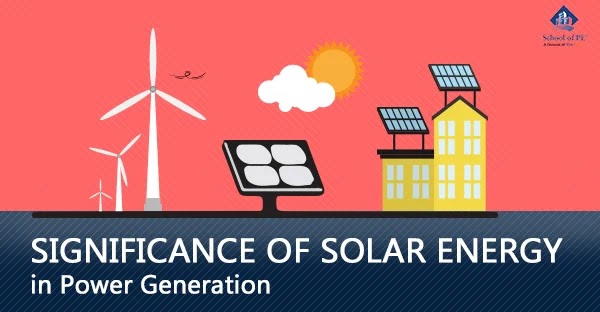Significance of Solar Energy in Power Generation for Mechanical Engineering Operations
Dec 08, 2016Table of Contents
1. Introduction
The sun emits very high, intensive energy in the form of solar radiation. The energy emitted by the sun in three minutes is equal to the world's energy consumption during a year. Most of the energy we receive from the sun is in the form of light by short-wave radiation, which is visible light to the human eye. When this radiation strikes a solid or liquid, it is transformed into heat energy. Within the past several years, solar panels have become increasingly popular as energy-saving devices that use this ideology. Solar panels are flat plate collectors that are used to collect solar energy. Solar energy has many uses including water pumping, solar heaters, solar driers, and solar power generation.

2. Arrangement of Solar Power Panels
In a flat-plate collector, radiation energy from the sun falls on the flat surface coated with a solar film. This surface has a high absorbing capacity and is placed toward the general direction of the sun for maximum efficiency. The materials used for the plates are copper, steel, or aluminum, and the thickness of the plate is approximately 1 to 2 mm. When evaluating the mechanics of a copper plate, thermal energy is transformed from the absorber plate to a fluid, which is then distributed in the copper tubes through the flat-plate collector. Panels are designed to have thermal insulation, with the preferred material being fiber glass behind the absorber plate to prevent heat loss from the rear surface. Engineering materials and their properties are important for the PE exam. Many PE review courses stress this topic.
3. Utilization of Solar Power Panels for Mechanical Engineering Applications
The solar panel collector reflecting surface is considered parabolic. The solar energy falling on the collector surface is focused on the absorber tube. When a large quantity of energy falls on the collector surface, it results in the temperature of the absorber liquid being higher than the flat plate collector. The flat-plate collectors may be used to heat water up to 80 degrees Celsius; the concentrators are designed to heat water from a medium temperature to high temperatures. The heated water in the flat plate solar collector is used for boiling butane under high pressure in the butane boiler; the boiling point of butane is about 50 degrees Celsius. The butane vapor, which is part of solar power plant arrangement, is used to run the steam turbine. This results in electricity.
PE mechanical engineering review courses cover the principles of turbines and boilers. Qualified mechanical or electrical power plant engineers with professional engineering licenses can install and setup solar power plants for mechanical engineering applications.
Advantages of Solar Energy
- The sun is an infinite source of energy, so solar energy is inexhaustible and renewable and available all over the world.
- It is environmentally clean and pollution free.
- It is the best alternative for the rapid depletion of fossil fuels.
Disadvantages of Solar Energy
- The intensity of solar energy on sunny days is approximately 1.1 KW/square meter area. Therefore, a very large collecting area is required.
- Collecting solar energy creates a need for a large amount of land.
- Solar energy is not available at night or on cloudy or rainy days.
Latest Blogs
Blogs by Year/ Month
Copied to clipboard



